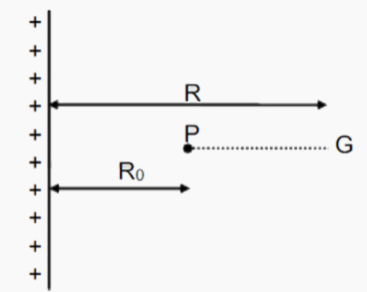Let E1(r), E2(r) and E3(r) be the respectively electric field at a distance r from a point charge Q, an infinitely long wire with constant linear charge density λ, and an infinite plane with uniform surface charge density σ. If E1(r0)=E2(r0)=E3(r0) at a given distance r0, then
Q=4σπr20
r0=λ2πσ
E1(r0/2)=2E2(r0/2)
E2(r0/2)=4E3(r0/2)
The correct Answer is:C
We can write electric field intensities as follows :
E1(r0)=14πε0Qr20….(i)
E2(r0)=λ2πε0r0….(ii)
E3(r0)=σ2ε0…(iii)
E1(r0)=E2(r0)⇒14πε0Qr20=λ2πε0r0⇒Q2r0=λ ...(iv)
E2(r0)=E3(r0)⇒λ2πε0r0=σ2ε0⇒λ=πσr0 ....(v)
E1(r0)=E3(r0)⇒14πε0Qr20=σ2ε0⇒Q=2πr20σ.....(vi)
From equation (vi) we can see that option (a) cannot be correct.
From equation (v) we can see that option (b) cannot be correct.
From equation (i) we can write
E1(r0/2)=14πε04Qr20=Qπε0r20...(vii)
From equation (ii) we can write
E2(r0/2)=λπε0r0...(viii)
Substituting the value of λ from equation (iv) in equation (viii) we can write :
2E2(r2/2)=2Q2r0πε0r0=Qπε0r20....(ix)
From equation (vii) and (ix) we can see that E1(r0/2)=2E2(r0/2) , hence option (c ) is correct .
From equation (iii) we can write the following :
4×E3(r0/2)=2σε0 ...(x)
From equation (v) we can substitute σ in equation (x). We get the following :
4×E3(r0/2)=2λπr0ε0=2λπε0r0....(xi)
From equation (viii) and (xi) we can see that option (d) is not correct.
Topper's Solved these Questions
- ELECTRIC CHARGES AND FIELDS Book:MODERN PUBLICATIONChapter:ELECTRIC CHARGES AND FIELDS Exercise:COMPETITION FILE ( Objective Question (C.MCQ))
Explore 19 Videos
- ELECTRIC CHARGES AND FIELDS Book:MODERN PUBLICATIONChapter:ELECTRIC CHARGES AND FIELDS Exercise:COMPETITION FILE ( Objective Question (D.MCQ) Passage )
Explore 10 Videos
- ELECTRIC CHARGES AND FIELDS Book:MODERN PUBLICATIONChapter:ELECTRIC CHARGES AND FIELDS Exercise:COMPETITION FILE ( Objective Question (BB.MCQ))
Explore 22 Videos
- DUAL NATURE OF RADIATION AND MATTER Book:MODERN PUBLICATIONChapter:DUAL NATURE OF RADIATION AND MATTER Exercise:CHAPTER PRACTICE TEST
Explore 15 Videos
- ELECTROMAGNETIC INDUCTIONBook:MODERN PUBLICATIONChapter:ELECTROMAGNETIC INDUCTIONExercise:CHAPTER PRACTICE TEST FOR BOARD EXAMINATION
Explore 14 Videos
Similar Questions
Knowledge Check
Electric field at a point of distance r from a uniformly charged wire of infinite length having linear charge density λ is directly proportional to
Ar−1BrCr2Dr−2A charge particle q is released at a distance R∘ from the infinite long wire of linear charge density λ. Then velocity will be proportional to (At distance R from the wire)
 AR3BeR/R0CR2D[n(RR0)]−1/2
AR3BeR/R0CR2D[n(RR0)]−1/2For a long wire of charge density γ,, field at a distance r from the wire is
Aγ2πε0rnBγ4πε0rnC0Dkqεe
Electric field due to an infinite non-conducting sheet of surface charge density σ, at a distance r from it is
View SolutionElectric field at a point near a uniformaly charged infinite plane sheet having surface density of charge σ is given as E= ________________
View SolutionElectric field 'E' at a point situated at a normal distacne 'r' from an infinitely long uniformaly charged straight were is proportional to
View SolutionLet E1andE2 denotes gravitational field at distance r1andr2 from the axis of an infinitely long solid cylinder of the radius R. Which of the following must hold true ?
View SolutionThe electric field due to point charged at a distance R form it is E. if the same charge is placed on a metallic sphere of Radius R, the electric field on the surface of the sphere will be
View Solution

